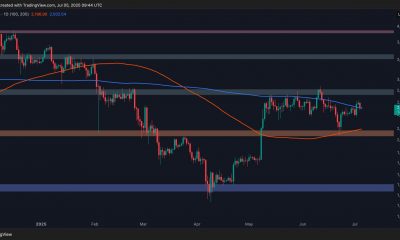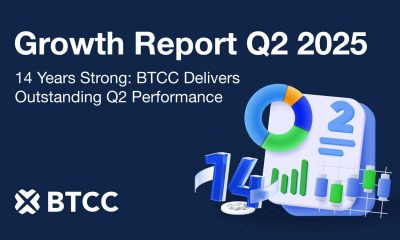Uncategorized
‘I’m out millions of dollars’: Thousands of crypto investors have their life savings frozen as Voyager files for bankruptcy protection

Robert first came across Voyager Digital in March 2020.
Like countless others, he decided to give the cryptocurrency broker a try. The platform was easy to navigate. It offered him an up to 9% annual percentage yield (APY)—much higher than a traditional savings account. It claimed to be FDIC (Federal Deposit Insurance Corporation) insured. And being a publicly traded company on the Toronto Stock Exchange, he thought, how bad could Voyager be?
Robert, who asked to be identified by only his first name for privacy reasons, ultimately invested six figures on Voyager, or 70% of his savings, he tells Fortune. Another user, who invested on Voyager for about six years and asked to remain anonymous due to safety concerns, has about $38,000 invested on the platform.
But now, both of them are unable to withdraw any of their money, as the company suspended trading on July 1 and filed for Chapter 11 bankruptcy protection late Tuesday.
Voyager also is not FDIC-insured, despite its advertisements that “In the rare event your USD funds are compromised due to the company or our banking partner’s failure, you are guaranteed a full reimbursement (up to $250,000).” Its “banking partner,” Metropolitan Commercial Bank, is FDIC insured, but Voyager is not.
Learning this, the user of six years said, was “like a kick in the stomach.”
“Every day, honestly, I cry,” Robert says. “I don’t know what to tell my wife. As partners, we decided to [invest on Voyager], but she trusted me, more than anyone else, to make the proper decision.”
Now these investors are learning how overleveraged Voyager was, and how it invested their savings in a now-defunct hedge fund that engaged in extremely risky behavior.
‘It’s heartbreaking’
Voyager has mainly blamed defunct hedge fund Three Arrows Capital (3AC) for its troubles, saying 3AC has not repaid a $650 million loan.
Like the rest of the crypto market, 3AC took a hit after the Terra ecosystem collapse in May. By June, major cryptocurrency lender Celsius Network was rumored to be bankrupt, and 3AC wasn’t far behind. Their failures set off a domino effect throughout the industry as many of the major crypto lenders and funds seemed to be exposed to each other, and last week, 3AC creditors sought its liquidation in a court in the British Virgin Islands.
Voyager, however, is trying to restructure and not liquidate, meaning that it hopes to return at least a percentage of its customers’ investments, according to its court filings. Voyager also said in court filings that it may potentially offer shares or tokens in its reorganized company to customers post-bankruptcy. But in the meantime, its customers struggle being unable to withdraw their savings. As they await next steps, some have even shared thoughts of suicide and depression online.
“It’s heartbreaking,” Robert says. “I feel extremely awful because I was unprepared.”
Voyager acted like a bank, and most of its users treated it as such. Over time, the broker began offering customers high yield for their deposits. To make good on their offerings, Voyager lent such funds to others for sometimes even higher yield.
Up until the company announced it was pausing withdrawals and filing for bankruptcy protection, Voyager continued to tell customers that it was doing fine.
Just weeks before Voyager filed for bankruptcy protection, CEO Stephen Ehrlich stated that customers’ assets were safe. In early June, Voyager tweeted that all “products and services are fully operational and remain unaffected by current market conditions, including trading, rewards, deposits, and withdrawals. We take risk management very seriously, and safeguarding customer assets is our number one priority.”
The company stated that it “never engaged in DeFi [decentralized finance] lending activities.”
Regardless of whether it engaged in DeFi lending or not, Voyager’s overexposure to 3AC became obvious once the market took a turn for the worse. The company hoped to shore up its finances after securing a roughly $500 million line of credit from quant trading shop Alameda Ventures in late June. But, still worried about a “run on the bank” due to users attempting to withdraw their funds, as its court filing states, Voyager ultimately decided to move forward with filing Chapter 11.
“I had no idea that Voyager would be lending [customers’ USDC] out to a hedge fund,” said the user of six years. “Had I known that it would be possibly lent out, I probably would have just kept it in cash in my safe.”
“I did every single thing a reasonable person would do, which is go through and look at the company,” Robert said. He noticed that the company wasn’t targeted by regulators and thought that was a good sign. “I should have known. Everything in hindsight, obviously, is a different thing.”
Scott Melker, a well-known crypto investor and podcaster with over 851,000 Twitter followers, tells Fortune that he has been using Voyager since 2019 and has “multiple seven figures” stuck on the platform.
It “hurts” being unable to access an account he used for savings, he says, but notes that he’s hedged his portfolio and understands that he took a big risk. Mostly, Melker feels badly about those he told Voyager about, including friends, family and his viewers.
“I understand that people make their own decisions, but they wouldn’t have even thought about it if I had not brought [Voyager] to their attention. And, frankly, that’s worse than losing my own money,” he said.
What’s ahead
A bankruptcy lawyer and a crypto lawyer told Fortune that it’s unclear how long the bankruptcy process will take. But, they emphasized that Voyager is hoping to restructure, not liquidate, a hopeful sign for retail investors getting any of their money back.
The company mentioned it hopes to provide its users with at least some of their funds after it reorganizes. Due to the variety of assets users bought on the platform, it’s uncertain whether users can be made entirely whole.
Melker tells Fortune that he is one of the top 50 asset holders on the platform, and the top 10 or 20 holders might have a say in what happens moving forward in the bankruptcy procedure, citing a hearing that just happened.
Voyager recently said it had approximately $1.3 billion of crypto assets on its platform, adding that the company has over $110 million of cash and owned crypto assets on hand, which will “provide liquidity to support day-to-day operations during the Chapter 11 process,” it says. Voyager also mentioned it has $350 million of customers’ cash held in an account at Metropolitan Commercial Bank.
This experience has scarred some to such an extent that they’ve vowed to never invest in cryptocurrency again. Others, in contrast, remain bullish.
Melker, for example, doesn’t have anything against the company or its creators. His history with Voyager runs deep—the company even briefly sponsored his podcast for a small period of time when he first started it, he says. He is hopeful that he and others will see their assets again.
“Listen, I’m out millions of dollars,” he says. “You know, it’s embarrassing. I’m a person who talks about risk management and protecting your assets, but I was arguably, in hindsight, overexposed, but it was what I was comfortable with.”
Of course, Voyager users are also hoping that they will soon have access to their savings.
“Hope, unfortunately, is not a plan, but there’s nothing I have control over,” Robert says. “All I need is to get my original assets back. I don’t need the rewards or the interest earned. I just need the assets back.”
Voyager Digital did not immediately respond to Fortune’s request for comment.
This story was originally featured on Fortune.com
Uncategorized
BofA Securities maintains Amazon.com at ‘buy’ with a price target of $154.00
Uncategorized
Six people in critical condition, one still missing after Paris blast – prosecutor

5/5
© Reuters. French firefighters and rescue forces work after several buildings on fire following a gas explosion in the fifth arrondissement of Paris, France, June 21, 2023. REUTERS/Gonzalo Fuentes
2/5
PARIS (Reuters) – Six people remained in a critical condition and one person was believed still missing on Thursday, one day after a blast ripped through a street near Paris’ historic Latin Quarter, the city’s public prosecution office said. “These figures may still change,” prosecutor Maylis De Roeck told Reuters in a text message, adding that around 50 people had been injured in the blast, which set buildings ablaze and caused the front of one to collapse onto the street. Of two people initially believed missing, one has been found in hospital and is being taken care of, the prosecutor said, adding: “Searches are ongoing to find the second person.” Authorities have not yet said what caused the explosion, which witnesses said had followed a strong smell of gas at the site. The explosion led to scenes of chaos and destruction in the historic Rue Saint Jacques, which runs from the Notre-Dame de Paris Cathedral to the Sorbonne University, just as people were heading home from work. It also destroyed the facade of a building housing the Paris American Academy design school popular with foreign students. Florence Berthout, mayor of the Paris district where the blast occurred, said 12 students who should have been in the academy’s classrooms at the time had fortunately gone to visit an exhibition with their teacher.
“Otherwise the (death toll) could have been absolutely horrific,” Berthout told BFM TV. She said three children who had been passing by at the time were among the injured, although their lives were not in danger.
Uncategorized
4 big analyst cuts: Alcoa & DigitalOcean shares drop on downgrades

© Reuters.
Here is your Pro Recap of the biggest analyst cuts you may have missed since yesterday: downgrades at Alcoa, DigitalOcean, Teleflex, and Xcel Energy.InvestingPro subscribers got this news in rapid fire. Never be left in the dust again.Alcoa stock drops on Morgan Stanley downgrade Alcoa (NYSE:) shares fell more than 3% pre-market today after Morgan Stanley downgraded the company to Underweight from Equalweight and cut its price target to $33.00 from $43.00, as reported in real time on InvestingPro.The firm sees a significant decline in consensus estimates, and as negative earnings revisions materialize, it believes the stock will face downward pressure and underperform.The analyst’s estimates for EBITDA in Q2, 2023, and 2024 are substantially lower than the consensus. The stock is currently trading above its historical average. The firm said its downward revisions in earnings estimates and price target are attributed to the company’s high operating leverage to aluminum prices.DigitalOcean stock plunges on downgradePiper Sandler downgraded DigitalOcean (NYSE:) to Underweight from Neutral with a price target of $35.00. As a result, shares plunged more than 5% pre-market today.The company reported its last month, with revenue beating the consensus estimate, while EPS coming in worse than expected. Furthermore, the company provided a strong outlook, which was above the Street estimates.2 more downgradesTeleflex (NYSE:) shares fell more than 3% yesterday after Needham downgraded the company to Hold from Buy, noting that UroLift expectations may still be too high.According to Needham, their checks indicate that urologists are reducing their use of UroLift due to its retreatment rates, reimbursement cuts, and increasing use of competing procedures. This is also supported by their Google Trends data analysis, which indicates decreasing search interest in UroLift.BMO Capital downgraded Xcel Energy (NASDAQ:) to Market Perform from Outperform and cut its price target to $64.00 from $69.00 to reflect the lower-than-expected terms of the company’s regulatory settlement in Colorado.Amid whipsaw markets and a slew of critical headlines, seize on the right timing to protect your profits: Always be the first to know with InvestingPro.Start your free 7-day trial now.

 Forex3 years ago
Forex3 years agoForex Today: the dollar is gaining strength amid gloomy sentiment at the start of the Fed’s week

 Forex3 years ago
Forex3 years agoUnbiased review of Pocket Option broker

 Forex3 years ago
Forex3 years agoDollar to pound sterling exchange rate today: Pound plummeted to its lowest since 1985

 Forex3 years ago
Forex3 years agoHow is the Australian dollar doing today?

 Cryptocurrency3 years ago
Cryptocurrency3 years agoWhat happened in the crypto market – current events today

 World3 years ago
World3 years agoWhy are modern video games an art form?

 Commodities3 years ago
Commodities3 years agoCopper continues to fall in price on expectations of lower demand in China

 Economy3 years ago
Economy3 years agoCrude oil tankers double in price due to EU anti-Russian sanctions




























